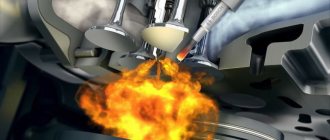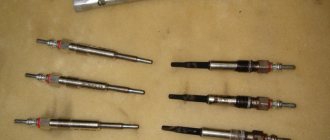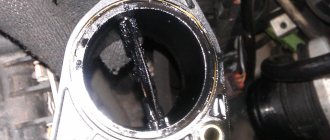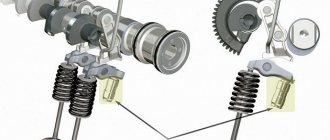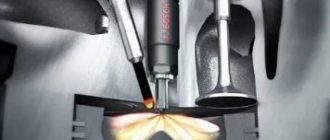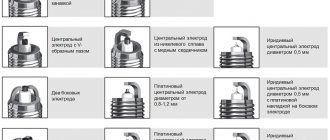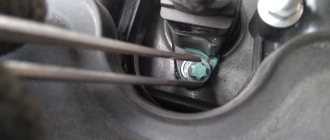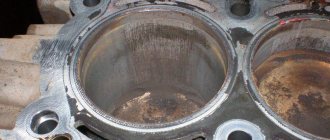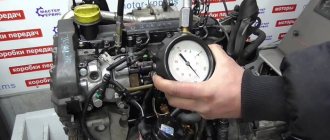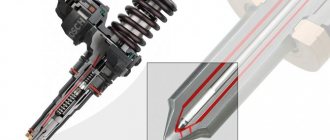Symptoms of faulty glow plugs in a diesel engine:
Starting the engine is difficult;
The car won't start;
Rough engine operation at idle speed;
White exhaust smoke (when cold, imitation of a rich mixture).
Most often, this problem begins to manifest itself with the arrival of the first cold weather, because... the part does not provide normal heating of the chamber for fuel ignition.
It is quite difficult to check the performance of glow plugs in a diesel engine. You will need special equipment, but we will talk about this a little later.
Causes of malfunction of glow plugs in a diesel engine:
Resource development;
Low quality;
Bad fuel or any other problems with the fuel system;
Problems in the wiring or control unit.
Similar articles
Replacing glow plugs on diesel cars: instructions, car service services
Whatever it is, we advise you to immediately contact a car repair shop, otherwise, you can significantly damage your car, then the cost of repairs will be much higher than the money for replacing spark plugs.
It is also worth noting that there is a significant difference in the performance of glow plugs in modern and older engines. In older engines, the fore chambers are located in the heads, and the spark plug must warm up the incoming fuel.
In modern For engines, the chamber is located in the piston, so the glow plug fires before injection and has the function of warming up the chamber, after which cold fuel and air enter there. Such conditions are more favorable for igniting the mixture.
The failure of one spark plug will manifest itself in a difficult start, the car will begin to actively “act up” at idle. If 2 spark plugs break, the diesel engine simply won’t start. The likelihood of all of them failing at once is extremely low, but if this happens, then diagnostics of all electrical wiring and the control unit is necessary.
Remember, change the entire set, even if only one spark plug fails! Be careful with the wiring, control relays and injectors. Their diagnostics are not expensive, but can protect your car from serious damage.
Now let's talk about how to avoid problems with glow plugs in a diesel engine?
- Mandatory diagnostics before the autumn-winter period.
- Buy only quality candles.
Methods for checking glow plugs on a diesel engine.
Let’s immediately say that the verification methods are not simple and you may need the help of a second person or special equipment.
1 way. Take a faithful comrade. One of you should turn out the injectors, the other should turn the ignition key to the pre-start position. A comrade looks into the wells and observes the heating or not heating of the candles. What doesn't work is dead and needs to be replaced.
The method is interesting and educational, but not suitable for every car. Since the engine design is not the same everywhere. Only fits 1.8 on Fords.
Similar articles
The injector fills the spark plugs with gasoline: what to do?
Method 2. You will need a multimeter and courage. We select the circuit check mode, touch the plug body with one probe, and the cap with the other (where the body is located and where the cap is is described in detail in the article “Glow plugs for a diesel engine”). If the circuit is closed, then everything works; if not, then replacement is required.
Such diagnostic schemes are not so relevant for modern cars; all new diesel cars have an indicator on the driver’s control panel. But! Like any other electronics, it can also fail.
Therefore, when winterizing your car, pay attention to the glow plugs
Do not try to change glow plugs on a diesel engine yourself. For example, it failed ahead of time, which means it is defective. When you try to unscrew it, it may simply fall apart, then you will have to remove the block head and take out the broken element.
Frequency of replacing glow plugs on a diesel engine.
As a standard, they “go” 60,000 km. After this, replacement is necessary, but low-quality fuel and aggressive use of the car can significantly shorten the “life” of the spark plug. Check them at every maintenance.
Come to us to replace glow plugs in a diesel engine. We will carry out all work quickly and efficiently. Remember that we have a service for selecting auto parts. Just tell the operator your details, we will offer you several options for details to choose from. All you have to do is come to us!
All questions by phone.
You can get any advice, as well as a 3% discount on all services and materials, in our group at.
Similar articles
We select spark plugs denso, ngk, bosh, beru, champion by car make
| Maintenance prices |
Checking the battery
This method involves removing all the glow plugs. This is labor-intensive and time-consuming work, part of which is opening up access to the products themselves.
But on the other hand, this is the most informative method, which guarantees a good result, since each candle is in front of your eyes and the entire heating process is clearly visible. You can immediately visually identify obvious shortcomings.
To check, you will need a charged battery and a cable up to 1 meter long, but not less than 50 cm.
The peculiarity is that you can control each candle separately or connect everything in parallel (the same current will flow to all elements).
The latter method will be preferable, as it will allow you to immediately visually assess the heating rate of all rods, which should be the same (the difference is no more than 1 s), but will also require a larger number of strands and preparation time.
Inspection procedure:
- One wire is connected to the “-” terminal of the battery;
- The central part of the glow plug is pressed against the terminal;
- We press the negative thread to the body of the product.
The barrel should heat up quickly (on average 2-5 seconds) from the tip and have a cherry tint. If there is no heat or it is slow, the spark plug is faulty.
It is recommended to measure the heating time of the tip of each candle from the start of heating until it turns cherry in color for later comparison.
Glow plugs with the same heating time should be divided into groups. The group included in the average warm-up time of 2-5 seconds remains, the rest are replaced.
Proper heating.
Wrong.
The ideal option would be when you have a new glow plug and its characteristics can be used as a reference.
As for heating elements that heat up very slowly, the situation is clear, but many will have the question: “why throw away candles that heat up too quickly?”
Heating too quickly means that the food is not fully heated, but only partially, i.e. The efficiency of their work is minimal, which means they do not perform their functions. Typically, such glow plugs have mechanical damage to the housing.
WHY IS THIS SO IMPORTANT? Let's imagine a situation where the air in the cylinders is heated at different intervals and poorly (the spark plug operates with low efficiency).
It turns out that in one cylinder everything is fine, the mixture ignites on time, in the other, on the contrary, the mixture ignites with a delay. This problem is indicated by vibration in the cabin and engine noise.
Checking glow plugs with a multimeter
A multimeter is a universal tool that should be in the arsenal of every car enthusiast. With its help, you can check the heating elements without removing them from the diesel block head. To verify the serviceability of the glow plugs using a multimeter, you must:
- Disconnect the wire from the spark plugs that supplies current to the central electrode. Depending on the design of the system, a separate wire may be connected to each spark plug, or they will all be connected by a bus to which the wire fits;
- Next, the multimeter will need to be switched to resistance measurement mode (Ohm);
- The positive probe of the device is connected to the central electrode of the spark plug being tested, and the negative probe must touch the body of the spark plug;
- If, as a result of testing, the resistance value remains at zero, this indicates a breakdown in the glow plug.
It is worth noting that this method allows you to determine only the breakdown of a glow plug. If the spark plug does not heat the combustion chamber sufficiently, it will not be possible to determine this when testing it with a multimeter.
How to connect glow plugs via relay circuit
This signal indicates a breakdown of the incandescent system
Let's take a closer look at what role the device plays, the principle of its operation and how to check the serviceability of the part.
Methods for checking glow plugs
Checking glow plugs using the battery.
This test method allows you to understand the cause of the malfunction of the heating elements. The principle is as follows: each glow plug is unscrewed and checked separately, and its external technical condition is analyzed, as well as its performance. The disadvantages include the need to unscrew the glow plugs; for some car models this is quite a big problem.
So, to check you will need a battery and a piece of wire half a meter long.
We take the glow plug, turn it over with the heating element facing up, then connect the central electrode of the spark plug to the “+” battery, and connect a piece of wire to the body of the spark plug and the “-” battery. If at the same time you see that the candle heats up quite quickly and evenly by more than half, you can conclude that the glow plug is in order. If the spark plug heats up slowly, or only the tip heats up, the spark plug is most likely faulty.
The second method will require a multimeter or ohmmeter.
Turn on the device in the resistance testing position (ohmmeter). Disconnect the power supply to the glow plug. We connect the positive electrode of the multimeter to the central electrode of the glow plug, and connect the second negative electrode to the body of the glow plug. Let's look at what the device shows: if the needle moves and has not deviated from the zero mark by a single division, most likely there is a breakdown in the heating element. Such a breakdown can be treated by replacing the glow plug. The disadvantage of this testing method is that it allows you to detect only a completely “dead” glow plug; it will not be possible to detect a weak glow of the heating element using this method.
The third method is to check the “spark” of the glow plug or check for spark formation.
Yes, that’s not a typo, these spark plugs are also tested for spark. The method is old, but very effective, because it allows you to check the degree of sparking of glow plugs. To check, you need to have a piece of wire (half a meter to a meter), the ends of which will be stripped on both sides (remove 2-3 cm of insulation on each side). We remove the glow plugs and turn off the power. After this, we connect one end of the wire to the “+” of the battery, and with the other end we quickly make a tangential movement along the central electrode of the glow plug. In short, touch should be similar to striking matches on a matchbox. During the test, a working heating element should exhibit a strong spark. If the spark is weak, the glow plug heats up slightly and may soon fail completely. A completely “dead” glow plug will not produce any spark at all. The disadvantage of this test is that on new cars “stuffed” with electronics, this method can damage the ECU. Therefore, before checking the glow plugs for a spark, make sure that this method will not harm your car.
Where is the glow plug relay located, how to check and change it?
Since this relay is an electrical device, the process of checking it is significantly simplified. For this you will need a multimeter. First you need to find this relay. It can be made in the form of a separate block or box that is attached to the car body. The attachment point to the body is called the “ground”.
Through this connection, power is supplied from the negative terminal. All other ends are positive. The relay receives additional information on special terminals from the engine control unit. The block processes information from temperature sensors and creates the necessary impulse at the relay input, which causes it to close and open. This indicates that an additional set of wires is connected to the relay.
The easiest way to find this relay is by the wires coming out of the spark plugs. Next, switch the multimeter to measure voltage and measure it with the ignition on at the relay output. To do this, one of the probes is pressed against the terminals leading to the glow plugs, and the other to the car body. The output voltage must be at least 12 volts. As a last resort, measure the voltage at the battery terminals, and if it turns out to be 12 or more, and 11 at the relay, then it is considered faulty. Another way to check is to measure the resistance between the relay terminals. This is done individually for each type of device, since standard resistance values may vary.
There is another - indirect way of verification. To do this, unscrew the spark plugs, connect the wires with the relay to them and turn on the ignition. If the spark plugs start to heat up, then the relay is considered to be working. Otherwise, either the spark plugs or the relay itself are faulty.
To change the relay, you must first remove the wires from it leading from the electronic control unit and to the glow plugs. Then its fastening is unscrewed. After this, the ground connection point of the new relay with the body is thoroughly cleaned, and a new device is installed in place of the old one.
Before removing the plugs, you must remember their installation location, otherwise there is a risk of assembling the device incorrectly, which can ruin the operation of both the relay and the glow plugs. To avoid having to go under the hood again, it is also recommended to replace the spark plugs.
This completes the check and replacement of the glow plug relay. As you can see, this is not a complicated procedure and can be done on your own. We wish you good luck on the roads!
Types of glow plugs
Pin
There are two types of glow plugs for diesel engines:
They have a similar design, the difference lies in the working element. In pin type, the working element is a glow pin made of a thermo-corrosion rod, tightly pressed into the spark plug body. Inside it is compacted magnesium oxide powder and a spiral thread.
The electrical circuit of such a candle is quite simple. Current is supplied to the head, from it through a conductive rod to a metal filament consisting of two resistors - a heating and a control coil.
- The resistance of the first is constant, independent of temperature;
- the second spiral has a positive temperature coefficient.
The principle of its operation is that the higher the temperature of the motor, the lower the heating temperature of the spark plug (when the control coil heats up, its resistance increases and less current is supplied to the heating coil). Such a spark plug heats up to 850 degrees, its operating time ranges from 4 seconds to two minutes and depends on the temperature of the motor and the parameters of the spark plug itself.
The duration of fuel heating is regulated by a control unit that monitors the readings of the coolant temperature sensor. There is a warning lamp on the instrument panel indicating that the heating is working. When it goes out, the engine is ready to start. There are two options for turning on the glow plugs: the ignition key is turned to the second position, or the preheating is turned on when the driver's door is open. Plugs that continue to burn after the engine starts help reduce warm-up time and ensure more complete combustion of fuel, thereby reducing emissions of harmful substances.
Ceramic
Ceramic glow plugs are the second type of heating devices. Its electrical circuit is no different from the previous one. The working element of such a candle is a ceramic rod, inside of which there is a ceramic heating element. Within two seconds, the rod heats up to 1000 degrees, resulting in a quick start of the diesel engine, like a gasoline power unit, without the “swing” characteristic of most diesel engines.
The heating voltage is not constant, it has three phases. During the rapid warm-up stage, it ranges from 9.8 to 11.5 V, while the rod heats up to the maximum possible temperature. When the engine starts, the supplied voltage gradually decreases to a level below the voltage of the vehicle’s on-board network: in the second phase to 7 V, in the third – to 5.
In addition to these three phases, there is an intermediate glow mode designed to restore the particulate filter. This helps improve combustion conditions during the reduction process.
Ceramic glow plugs have a number of advantages over pin plugs with a heated spiral. The most significant ones are a higher heating temperature, which ensures better performance of spark plugs during cold starts, lower toxicity of exhaust gases, longer service life, and greater efficiency (their heating temperature at the same voltage is much higher).
Manufacturers often install spark plugs with a built-in pressure sensor on diesel engines. Its readings help to adjust the heating temperature of the candle and increase its efficiency.
Varieties of candles
When deciding how to check the performance of glow plugs on a diesel engine, you need to know what types of them exist. For diesel engines they are available in two types:
- ceramic;
- pin.
The former have a tip made of ceramic, which withstands temperature changes. The protective shell is made of silicone nitrite. The heating of such a spark plug reaches 1000°C, and the engine starts without problems. Such parts are highly efficient and have a long service life.
For pin candles, the heating element is made of an alloy of iron, chromium and nickel, and the internal cavity is filled with magnesium oxide. This candle works at intervals from 4 seconds to 2 minutes.
Methods for checking glow plugs for diesel engines
The failure of one or two glow plugs may not be noticeable in relatively warm weather. And when frost sets in, difficulties immediately arise in starting the diesel engine.
We will describe three different ways to test the performance of glow plugs. The choice of each of them depends on whether the motorist has certain devices, tools, skills and free time.
Method 1 - Checking glow plugs using a battery
The most accurate and clear picture of the serviceability of heating elements for a diesel engine is given by checking the battery. Each spark plug is checked separately, and the car enthusiast sees the degree of its glow.
The disadvantage of this diagnostic method is the need to unscrew all the glow plugs. This will require a significant amount of time in some cars, as well as the dismantling of some parts that make access to the heating elements difficult.
- To carry out the tests, you will need an insulated wire about 0.5 m long.
- The glow plug is turned upside down by the heating element and installed with the central electrode on the positive terminal of the battery.
- Using an electric wire, you need to connect the negative terminal of the battery and the spark plug body (in the side part).
- If the heating element quickly heats up by more than half, then the spark plug is working.
- If there is no glow or only the tip of the element is heated, the spark plug needs to be replaced.
Below are easier ways to check glow plugs.
Method 2 - Checking the glow plugs with a multimeter
Sometimes there is no time or tools to remove the glow plugs from the head of a diesel engine. In this case, checking with a multimeter may be useful. The device is installed in the position for testing resistance (ohmmeter).
But first you need to disconnect the wire from the glow plugs that supplies current to the central electrode. Each heating element can be supplied with a separate wire, or all candles can be connected by a copper or brass busbar. Now all that remains is to connect the positive probe of the multimeter to the central electrode of the spark plug, and touch the negative probe to the side surface of the housing. If the arrow does not deviate or there is no reading on the digital display, then there is a breakdown in the heating element. The glow plug needs to be replaced.
The disadvantage of this method is the difficulty of identifying heating elements with low heat. The tester will show that there is no breakdown, and the spark plug will not warm up the combustion chamber sufficiently.
Method 3 - Checking the glow plugs for a “spark”
An old, tried-and-true way to check the health of glow plugs is the degree of sparking. To do this, you will need an insulated wire 0.5-1 m long, at both ends of which 1-2 cm of insulation is removed.
Now you need to free the glow plugs from the tire and supply wire. One end of the test wire is attached to the positive terminal of the battery, and the other end makes a tangential movement along the central electrode of the glow plug (see the video below). Thus we will be able to observe something like the following:
- A strong spark forms on a working heating element.
- If the spark plug is weakly heated, sparking will be insignificant.
- A completely faulty glow plug will have no spark at all.
This check can be safely done on old cars that do not have “brains” and a computer. In the video below, glow plugs are checked in this way on a diesel Nissan Primera.
The above methods for checking glow plugs allow you to independently discover the cause of poor starting of a diesel engine. If a faulty part is identified, the car owner will only have to replace the failed heating element. After this, starting the engine in the cold is usually not difficult.
Also, in the winter season, owners of cars with diesel engines will benefit from an engine pre-heater.
Checking with a multimeter (tester)
The diesel engine glow plug tester is used in three modes:
- Measuring resistance readings;
- By composition method (if supported);
- Indication of current consumption measurement.
All methods can be used without removing the product from the engine. But this way we will only answer the question: “Does the candle work well or not?” It will not be possible to find out what condition it is in and the reasons for its failure.
Chain ringing
To confirm using the dialing method you must:
- Disconnect the power cord from the glow plug;
- Set the regulator on the tester to the desired position;
- Press the negative probe on the motor block, the positive probe on the electrode.
- The presence of sound indicates that the spiral is intact.
When using an analog tester, you need to focus on the arrow; its deviation indicates the integrity of the circuit.
You can also do this on a removed spark plug, only instead of a block, the probe must be attached to the body of the product.
The first and third methods are more informative, but there are some features that are important to know.
Resistance measurement
It is important to understand the principle of the relationship between the ECU and the spiral resistor, which in a new glow plug should be in the range of 0.7-1.8 Ohms.
The ECU controls the current consumed by the heating elements (A), which varies depending on their heating. The amount of current is inversely proportional to the amount of resistance.
Those. Glow plugs go out when their resistance increases due to heat and the current passing through the coil decreases. When a certain current value is reached, the computer receives a signal that the spark plugs are hot and need to be extinguished.
If the resistance is too high (more than the nominal value) due to a faulty heating element, the current decreases earlier than necessary.
At this moment, the ECU receives a signal (premature in our case) that the glow plugs have become hot and, as this happens, they need to be turned off. At the same time, the air temperature in the cylinders remains low for safe engine starting.
Current consumption measurement
The most informative method involves starting a still cold engine. These glow plugs do not need to be removed.
By measuring current consumption, you can quickly identify a faulty heating element. In this case, the reliability of the result will be close to 100%.
But here it is important to understand what types of glow plugs are installed in the engine and what their standard current consumption is.
For example, if you take reed products, they can be unipolar or bipolar.
The first ones are connected according to the classical scheme: ground on the body, one terminal part. Consume from 5 to 18 A.
Seconds are determined by the presence of two pins; they can consume up to 50A.
To measure the current consumed, it is necessary to connect the tester in series in the “ammeter” mode to the electrical circuit that powers the glow plug.”
Because of this:
- Disconnect the power cord from the product;
- We switch the multimeter to ammeter mode;
- We connect one probe to the power cable, the second to the central socket of the glow plug.
- assistant required. We start the car (the engine must be cold) and take readings from the device.
In the first few seconds, the electrode resistance will be minimal, since the engine is still cold, and as a result, the tester will show the maximum current.
As the spark plug heats up, the resistance inside it will increase and the current will decrease. This will be displayed on the device. The decline should occur without sudden changes, gradually. And then, at some point, the current should stabilize.
It's best to record the results of each spark plug test so you can compare them later. They should be as identical as possible.
If the glow plug behaves differently, it is likely that only the center portion or tip will heat up. No current indicates an open circuit.
Here you will have to turn the product and double-check, but visually observing the heating process. This is usually already done with a directly connected battery (see below).
Why check the performance of glow plugs and relays?
Glow plugs are located directly in the combustion chamber. They provide heating of the fuel so that ignition is as smooth and clear as possible. We can say that they are a pre-starting device for the engine. Their performance is especially important in winter. Due to a malfunction in the glow parts control unit, the driver simply will not be able to start the engine.
They are made from different materials. They may have a closed or open heating element. Their control circuit takes into account fuel temperature, air heating, and resistance changes. When the engine does not start, many drivers initially check this particular system.
There are many reasons why spark plugs can fail. This is the expiration date of the element, the weather conditions of the region in which the car is used. The cause of the problem may lie in electrical wires or other system components.
The glow plug relay is an important part in the operation of a car.
The glow plug relay is a very important part that is part of any diesel engine. If a real part of the vehicle fails, starting the engine will be quite problematic. Especially if it’s frosty outside and the humidity is high. This is due to the fact that the incandescent elements in this case also stop working, they do not heat the combustion chambers of the diesel engine and starting it becomes impossible.
This signal indicates a breakdown of the incandescent system
Let's take a closer look at what role the device plays, the principle of its operation and how to check the serviceability of the part.
Signs of faulty glow plugs
Indirect signs of the presence of a malfunction:
- When starting, white-gray smoke comes out of the exhaust. This indicates that fuel is flowing but is not igniting.
- Rough operation of a cold engine at idle. The noisy and harsh operation of the engine can be noticed by the shaking plastic parts of the interior due to the fact that the mixture in one cylinder ignites late due to the lack of heating.
- Difficulty starting a diesel engine when cold. You have to do several repetitions of spinning the engine with the starter.
Clear signs of a bad glow plug will be:
- Partial destruction of the tip.
- A thick layer of carbon deposits on the tip near the body.
- Swelling of the glow tube (occurs due to excess voltage).
How can you check the glow plugs of a diesel engine?
How to check?
Depending on the model and age of the car, there are different principles of operation of the diesel engine heating system:
- In older cars, glow plugs usually turn on almost every time the engine is started.
- Modern cars can start successfully even without glow plugs at above-zero temperatures.
Therefore, before starting to diagnose the diesel preheating system, you need to find out at what temperature conditions the combustion chamber is heated. And also, what type of candle, since they are divided into two groups: rod (the heating element is made of a refractory metal spiral) and ceramic (the heater is ceramic powder).
To check the spark plugs of a Ford, Volkswagen, Mercedes or other car diesel engine, you can use several methods, and depending on whether they are unscrewed or on the engine, the principle will be the same. Functionality testing can be done using:
3 ways to check glow plugs - video
- Battery. On the speed and quality of incandescence;
- Tester. By checking the break of the heating winding or its resistance;
- Light bulbs (12V). The simplest test for breakage of the heating element;
- Sparking (can only be used in old diesel engines, since new ones are dangerous due to ECU failure);
- Visual inspection.
The simplest diagnosis of glow plugs is to check their electrical conductivity. The spiral must conduct current, its resistance in a cold state is in the range of 0.6–4.0 Ohms. If you have access to the candles, you can “ring” them yourself: not every household tester is able to measure such a low resistance, but any device will show the presence of a heater break (the resistance is infinity).
If you have a non-contact (induction) ammeter, you can do without removing the spark plug from the engine. But it is often necessary to inspect the working part, on which signs of overheating may be noticeable - melting, deformation of the tip, up to its destruction.
In some cases, in particular if all spark plugs fail at once, it may be necessary to check the vehicle's electrical equipment. Namely, the spark plug control relay and its circuits.
We will describe all the ways to check diesel glow plugs. The choice of each of them depends on skills, availability of equipment, tools and free time. But ideally, you need to apply everything together, plus a visual inspection.
VA-G › Blog › WHERE IS THE GLOW PLUG RELAY, DEVICE AND PRINCIPLE OF OPERATION
Glow plug relay To start the heart of a diesel car in frosty weather, the designers specially installed a glow plug relay on it. It is highly undesirable to allow this device to fail, but for various reasons it can still happen. In such a situation, it is very important to determine exactly what is causing the failure of the system - the relay itself, the spark plugs or the auxiliary systems. In the article below we will try to find out how to check the functionality of the glow plug relay on a diesel engine and how to replace it if necessary
Glow plug relay - basic functions
The glow plug relay of a diesel car is a device that activates the glow plugs, which directly heat the combustion chambers, that is, the prechambers, before starting the engine. But the relay does not independently decide when and for what period of time to activate the operation of the candles. This task falls entirely on the engine control unit, which analyzes the following information before turning on the glow plug relay:
• indicators of the coolant temperature sensor;
• temperature indicators on the crankshaft of a diesel engine.
What does the glow plug relay do? Activating it before starting allows you to warm up the engine to a temperature at which it is safe to start it. But this is where the work of only one-stage heating of diesel pre-chambers ends, although there is also a two-stage one.
Important! After the first stage of pre-chamber heating has completed, the glow plug relay operating light on the instrument panel will go out. This is a signal to the driver that the diesel engine can be started. Glow plug relay
In the latter version, the glow plugs are activated again - after the engine has started. Moreover, if at the first stage they warm up each cylinder head, operating from a voltage of 12 V, then at the second stage the voltage can drop even to a value of 5.5 V. This is necessary so as not to heat up the combustion chambers, but simply maintain the temperature and prevent it from falling. Thanks to this two-stage heating, the diesel engine runs more smoothly, the wear of its parts is significantly reduced and fewer toxic substances enter the exhaust pipe (this is due to the fact that, thanks to heating, the fuel mixture burns more smoothly). Moreover, depending on the ambient temperature, the warm-up time at the second stage may be different. But as soon as the coolant temperature sensor shows a value of +30˚С, the system will automatically turn off.
Failure of such a system is extremely undesirable for the driver. If this happens, it is very important to quickly find the cause of the breakdown and fix it. To do this, it is important to understand the design of the heating system for the pre-chambers of a diesel engine and the principle of their operation.
The design and principle of operation of the relay
The glow plug relay itself is a device that, upon certain commands, simply closes and opens a circuit, due to which the glow plugs can turn on or off. When voltage comes from the control unit, the relay automatically transfers it to the spark plugs. However, the glow plug relay connection diagram is not so simple. Between the relay and the spark plugs there is another device - a current-limiting resistor, which also has a direct connection with the control unit. Thanks to this, he receives information about the operation of the glow plugs and, if necessary, can turn them off.
Connection diagram for the glow plug relay It is immediately worth noting that many car owners, during self-repair of the glow plug relay and the entire pre-chamber heating system, underestimate the value of the current-limiting resistor and forget to connect it at all or do not connect it to the control unit. Such negligence can only lead to one thing - the glow plugs and relays will not work. So, under no circumstances should the installed connection diagram for the glow plug relay be changed, and when disassembling it, it is better to mark all the wires so as not to confuse them when connecting them back.
By Mercedes car
The glow plug relay block on a Mercedes is located under the battery platform, just like in Opel cars. If this part fails, it must be replaced.
During the repair process, it is worth considering not only the manufacturer of the spare part, but also the type of spark plugs that are installed on the car. If they are ceramic, then the relay for metal spark plugs will not function.
Of course, you can also repair spare parts yourself, for example, replace burnt wires with new ones. Or install another switch. But these manipulations can only aggravate the situation and lead to serious problems with the car’s electrical system.
Checking with a light bulb
This method involves the use of conventional control. This is not always possible and relatively informative, but it also has a right to life.
To check, a 12V 21 W light bulb will come out, for example, from the stops, on two wires. One of the wires can be shortened, the other must be long enough to reach the battery.
The check can be carried out both on the removed glow plug and on the one installed in the engine.
In the first case, the negative terminal of the battery will play the role of ground, in the second - the body of the diesel unit.
For control:
- Disconnect the power cord from the product;
- We connect one control wire to the positive terminal of the battery, the second to the spark plug terminals.
- If the test is carried out on removed heating elements, their housings should touch the negative terminal of the battery.
A bright light indicates that there is no break. Lack of light: there is a pause. But in what conditions the rods of the products are located is still not known.
The only thing that will indirectly direct us to the problem is the dim lighting of the lamp. This will make it clear that it is necessary to carry out more in-depth diagnostics of the devices, for example, using a tester.
Features of diesel engine operation in winter
The onset of winter is a difficult time not only for the driver, but also for his engine, especially the diesel one. Low temperatures make diesel fuel viscous, which complicates and complicates the process of forming a working mixture.
Additional load falls on the injectors, which have difficulty spraying the fuel-air mixture into the combustion chamber. At very low air temperatures, particles of atomized fuel fall out in the form of drops, onto the walls of the combustion chamber, complicating further processes.
Many diesel engines, not prepared for the onset of winter and high negative temperatures, lose power. The cars are shamelessly “stupid” and simply “refuse” to go. Rarely a driver in this situation will be able to restrain himself and not curse.
Relay operating principle
The principle of operation of the glow plug relay is to control the voltage supplied to the glow plugs and the ability to regulate it. The device also controls the heating duration and temperature. The performance of the part directly depends on the readings of the crankshaft speed sensors and coolant temperature.
Modern diesel devices are designed in such a way that heating is carried out not only before starting, but also after the engine starts running. This allows you to reduce noise when the engine is running and significantly reduce harmful emissions into the atmosphere.
How does ignition occur in a diesel engine?
Visual check of glow plugs
A visual check allows you to identify not only defects, but also the operation of the fuel system, the operation of the electronic control, the condition of the piston, so always carefully inspect the glow plugs since they have already been removed.
There are defects on the spark plug
If the spark plugs have not yet reached the end of their service life, but already have signs of overheating (approximately in the middle of the heated rod), the body swells and cracks spread along the sides, then this is:
- Voltage too high. You need to measure the voltage in the on-board network with a multimeter.
- The glow plug relay does not turn off for a long time. Record the response time by clicks or check the relay with an ohmmeter.
